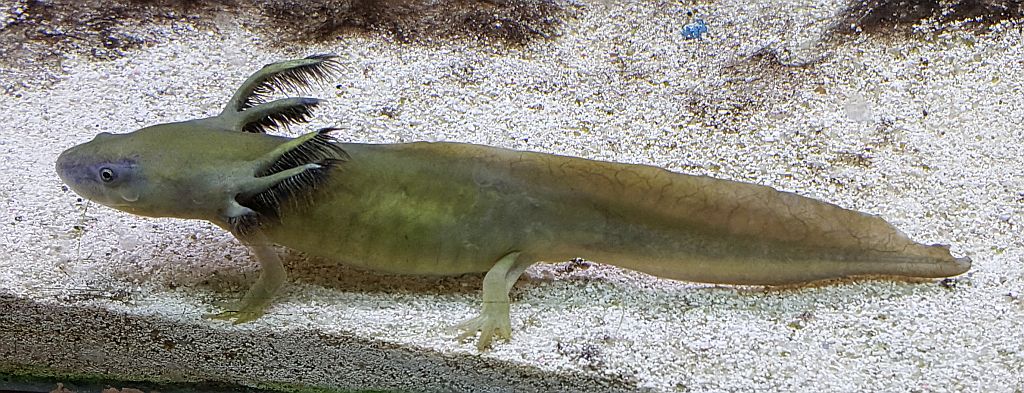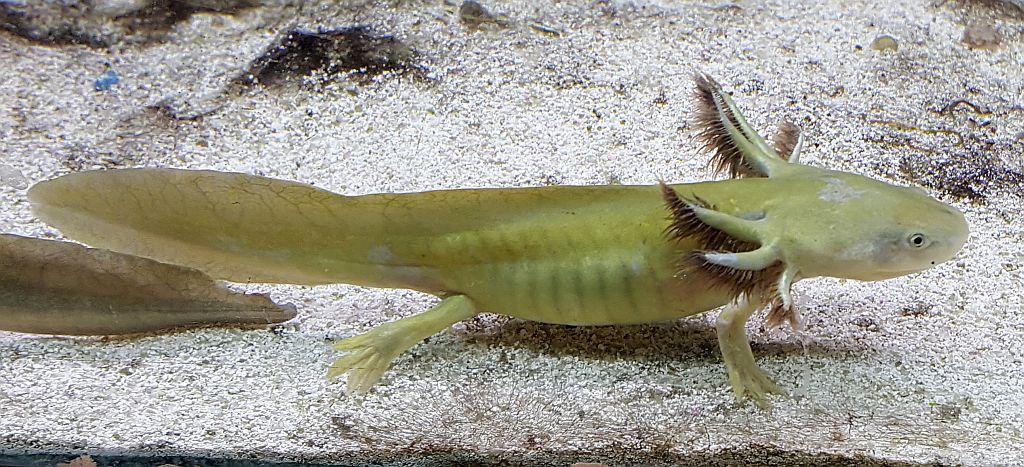Axolotl (Ambystoma mexicanum) were originally native to Mexico and are known to tropical fish keeping enthusiasts as Mexican salamanders (Ambystoma mexicanum) or Mexican Walking fish. Before Mexico City’s growth in the basin of Mexico, the Axolotl was native to two high altitude lakes, Lake Xochimilco and Lake Chalco. Of these two, only the remnants of Lake Xochimilco exists today, mostly as canals.
Axolotl are neotenic, and unlike other salamanders do not undergo a metamorphosis from the “larval” to adult form. The delicate looking externally gilled larvae are totally aquatic, become sexually mature, reproduce, and spend their entire lives underwater.
Although Axolotl are not common pets, many tropical fish keeping enthusiasts do keep them in a single species and even in community environments. They were considered an edible food source in Mexico, and are now commonly used in laboratory settings to study their regenerative capabilities. Although wild specimens are now considered critically endangered, huge numbers are bred in captivity making them occasionally available to tropical fish keeping enthusiasts.
Axolotls can occur in a variety of colors in captivity. They can be multiple shades of brown to almost black, melanoid, gray, cream, white with black eyes, golden albino, white albino, harlequin, and even piebald specimens in various colors.
Although the Axolotl’s gills and skin is soft and quite sensitive, they have amazing regenerative abilities. When injured, they heal quickly and when they lose a body part, it will grow back and eventually be replaced over time.
Because Axolotls can grow quite large, they need at least a 20 gallon aquarium with a coarse gravel substrate, some plants, a small piece of driftwood, and a few river rock formed into shelters for them to hide. They prefer subdued, low light conditions, and are extremely sensitive to nitrates, nitrites, drastic changes in water chemistry, and especially the chlorine and chloramines found in tapwater. Although they need a good filtration system in their tank, they do not like strong currents. A good outside hanging filter is an excellent choice for this species. Weekly 20% water changes should be considered routine maintenance for Axolotl.
Changes in the amount of daylight apparently trigger spawning activity in Axolotls. By artificially reducing and then gradually increasing the amount of daylight in their environment, Axolotls can be induced to breed almost any time of the year.
Spawning behavior is initiated by the male who leads the female around the tank, occasionally nudging her vent. The male will deposit between 5 and 30 sperm packets around the tank and try to lead the female over them. Fertilization takes place internally after she picks up one or more of the sperm packs into her cloaca.
Spawning takes place anytime from a few hours to a few days after fertilization. The female will lay each individual egg on a plant leaf, a clean rock, flowerpot, piece of pipe, or any other object in the tank until anywhere from 100 to 1,000 eggs are deposited. Once the female is finished laying her eggs, remove the pair from the spawning tank. At a water temperature of 68 °F , the eggs will hatch out in about 17 days, but it will usually not take longer than 2 to 3 weeks for fertile eggs to hatch in a well oxygenated tank with minimal water flow.
The eggs sacs will be absorbed within 24 to 72 hours at which time the fry will require food. Feed them newly hatched baby brine shrimp and baby Daphnia until they develop their front legs, then feed them daphnia and microworms until all their appendages have developed.
Here is an excellent site on Axolotl breeding.
Juveniles Axolotls are often cannibalistic towards each other when kept together, and in a rearing or community tank, will eat small their slower moving tank mates.
In the wild Axototls feed on worms, snails, small fish, crustaceans, and small amphibians. In an aquarium environment they will eat brine shrimp, earthworms, bloodworms, tubifex worms, small pieces of liver or beef, shrimp pellets, or commercial fish pellets. Indiana University even sells special Axolotl pellets from their colony. Feed them a couple of times a day and remove any uneaten food from the bottom on a daily basis to avoid fowling the water.
Although Axolotls are considered critically endangered, they are available online and from specialty pet shops as juveniles and adults.
Minimum Tank Size: 20 gallons
Care Level: Moderate
Temperament: Slow Moving, Peaceful
Aquarium Hardiness: Moderately Hardy
Water Conditions: 57-68 F , 4-15°dH , pH 6.5-7.5
Max Size: 14″
Color Form: Brown, White, Gray
Diet: Carnivore
Compatibility: Keep singly or with conspecifics
Origin: Mexico, laboratory bred
Family: Ambystomatidae
Lifespan: 10-15 years
Aquarist Experience Level: Intermediate



